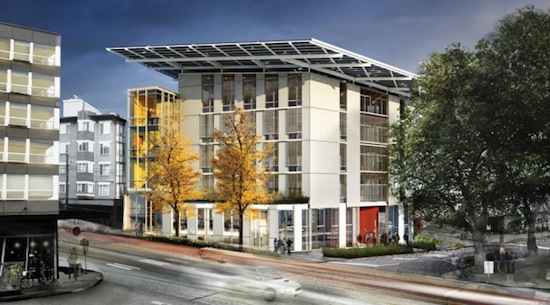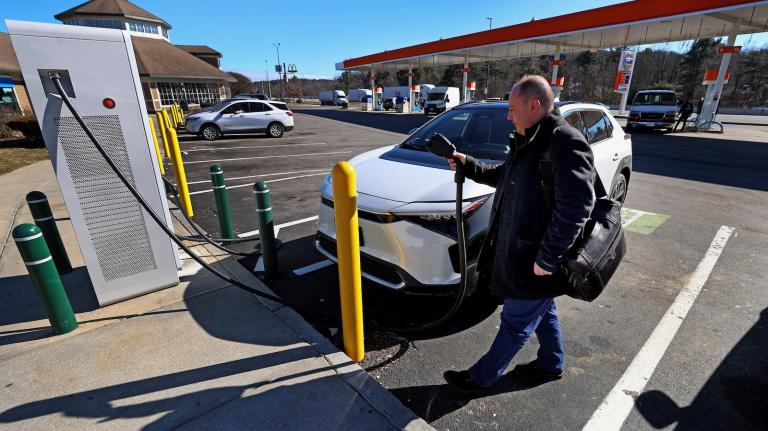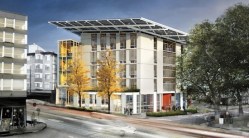
The Bullitt Center will feature 100 percent solar power, a rain garden, and composting toilets.
In 2009, Seattle set out to to create the next generation of cutting-edge green buildings and inspire other forward-thinking cities to follow suit. Three years later, only one of these space-age structures is under construction, with just two more in the planning stages. What happened to the Emerald City’s “deep green” dreams?
Under the Living Building Challenge Pilot Program, which went into effect in 2010, the city offered special incentives to the first 12 developers who managed to meet at least 60 percent of the requirements of the Living Building Challenge, a program that leaves the LEED green building standards in the dust. To win official Living Building status, a structure must, among other things, generate all its own electricity and only use water that falls on site. (The latter would be a piece of cake in Rain City. The former, not so much.)
But by the middle of this summer, with just months remaining before the program was set to expire, the city had found only three takers.
- The Bullitt Foundation is building a six-story, solar-powered office building that it touts as “the greenest commercial building on Earth” (special features include composting toilets and a water-filtering rain garden).
- Skanska USA is collecting permits and permissions to build a new, eco-groovy world headquarters for the Brooks running shoe company (replete with super high-tech hydronic heating and cooling system and meters that tell occupants how much energy they’re using).
- Schemata Workshop is developing a cohousing project in the city’s hiptastic Capitol Hill neighborhood (it will have a farm on the roof!).
Some impressive work, but certainly not the cavalcade of awesomeness that city leaders imagined when they launched the program three years ago.
The slow progress is the result, in part, of the floundering commercial real estate market. But there are a few other factors dampening Seattle’s green-building aspirations that other cities might learn from — and from which we all might benefit, if Seattle succeeds in its pioneering efforts:
1. Green buildings freak out the code cops. Over the years, we’ve developed elaborate regulations that do a lot of really good things, like preventing buildings from falling over on us. But the good people charged with enforcing these rules are not exactly the entrepreneurial, risk-taking types. Seattle wins some points for allowing green developers to deviate from its traditional regs, but there’s a long way still to go. Denis Hayes, the Bullitt Foundation’s president and CEO, hopes to pipe purified rainwater into the taps in his new office building, but he has yet to gain permissions from the appropriate local, county, state, and even federal agencies.
2. Bankers don’t know what to make of this stuff, either. Walk into your local mortgage bank sometime and ask if they’ll lend you a few mil to put up an office building powered by a bunch of solar panels on the roof, where workers shit in a glorified bucket, and see what they say. The typical building loan is based (long story short) on the amount of income the owners are likely to generate — read: the chances that you’ll be able to pay back the bank in a timely fashion. “Banks are very risk-averse,” says Lisa Picard, executive vice president at Skanska USA. “They want to make sure that things that get built look like everything that’s been built before.”
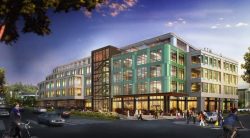
The Brooks shoe company’s new world HQ includes hydronic heating and cooling and real-time energy-use monitoring.
Skanska is funding its project completely out-of-pocket. Bullitt found a bank — U.S. Bank — that was willing to lend it enough to cover half of its construction costs, but Hayes says it took some hunting.
3. Green building is expensive. “Our best bet of reducing water consumption to the level we need to satisfy the [pilot program] standards is to use composting toilets — well, those are in the tune of $25K each,” writes Grace Kim, an architect with Schemata Workshop. “We’re not sure we can actually accomplish this within our project budget.”
Sure, these buildings will save money over the long haul because all their water and electricity come from the sky, but in Seattle, at least, both power and water are so cheap that it will take a very long time to pay back the initial investment.
The city has helped defray some of those expenses by allowing builders to deviate from building heights and street setbacks, thereby creating more space for lease. But if the city is serious about promoting this kind of work, Kim’s colleague Michael Mariano says it may need to pony up some cash via subsidies or tax abatement.
4. NIMBYism reigns. While Seattle’s pilot program (recently renamed Deep Green) enjoyed broad public support, comments at public meetings often started with, “I support green building, but …”
The Brooks shoe HQ drew the ire of nearby residents who complained, among other things, that it was too large and out of character with the neighborhood. The thing will be big, though at five stories high, it is hardly a “skyscraper,” as some critics have claimed. One non-fan, upset that the building (which has been pre-approved as LEED platinum) was not green enough, said that it was “like a bad drag queen — so bad that no one believes that he is who he purports to be.” Another said the site was “fine just as it is.” The spot currently houses a few ramshackle storefronts and a giant asphalt crater, home to a parking lot and a reeking transfer station for the local recycling program (local character!).
5. To make a “deep green” building work, you actually have to change people’s behavior. In Seattle, powering a five- or six-story building solely with solar panels on the roof means using substantially less electricity than your average office. Brooks employees may need to switch to more energy-efficient laptop computers, for example, or put on sweaters on chilly days if building managers allow the temperature to dip below a constant 70 degrees. They’ll also have to make better use of bikes and public transit — or tie on some of those fancy shoes and run to work — as the building won’t have as much parking space as similar structures in the area. (This, too, was a non-starter for the neighbors, who feared Brooks employees would poach their personal parking spots.)
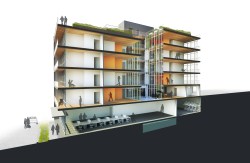
The Capitol Hill Cohousing project will be capped with a rooftop farm.
So what is Seattle doing now? In late July, the city council voted to extend the pilot program for another three years in hopes of attracting a few more eco-minded builders. Based on the results so far, it looks likely that the council will adopt a tiered system, providing more incentives to developers who want to explore deeper shades of green.
The city is adapting and adjusting to local realities, and in that sense, the program has been a success, says Katie Spataro, research director at the International Living Future Institute, which has published volumes about the challenges green builders face. Seattle’s pilot program, Spataro says, “is a great way to address regulatory barriers” — even if it does take a while for the city to find developers who want to dance.

